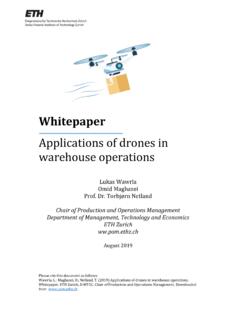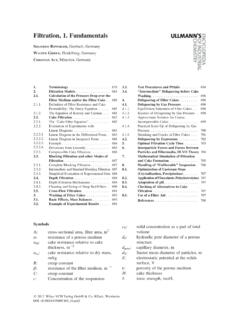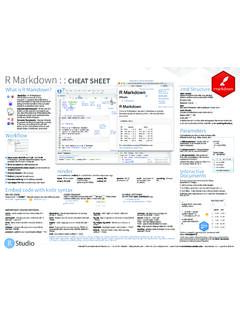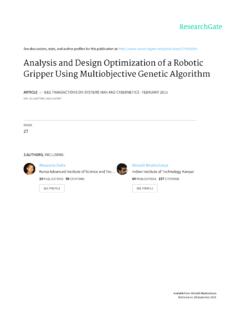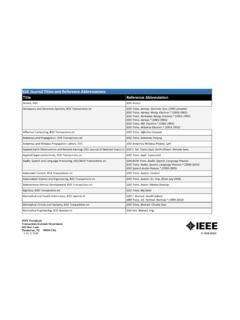Transcription of Robot Dynamics Lecture Notes - ETH Z
1 Robot Dynamics Lecture NotesRobotic Systems Lab, ETH ZurichHS 2017 Contents1 ..32 .. of Positions ..6 Cartesian coordinates ..6 Cylindrical coordinates ..7 Spherical coordinates .. Velocity .. of Linear Velocities ..7 Cartesian Coordinates ..8 Cylindrical Coordinates ..8 Spherical Coordinates .. Matrices .. vs. Passive Rotation ..11 Passive Rotation ..11 Active Rotation .. Rotations .. of Rotations .. of Rotations ..13 Euler Angles ..13 Angle Axis ..18 Unit Quaternions.
2 Velocity .. Derivatives of Rotation Parameterizations ..22 Time Derivatives of Euler Angles ZYX Angular Velocity .23 Time Derivatives of Euler Angles XYZ Angular Velocity .24 Time Derivatives of Euler Angles ZYZ Angular Velocity .24 Time Derivatives of Euler Angles ZXZ Angular Velocity .24 Time Derivative of Rotation Quaternion Angular Velocity .24 Time Derivative of Angle Axis Angular Velocity ..25 Time Derivative of Rotation Vector Angular Velocity .. in Moving Bodies ..28iSome Notes on Vector Differentiation.
3 Of Systems of Bodies .. Coordinates and Joint Configuration .. Coordinates ..31 End-Effector Configuration Parameters ..31 Operational Space Coordinates .. Kinematics .. Kinematics and Analytical Jacobian ..34 Position and Rotation Jacobian ..35 Dependency on Parameterization .. or Basic Jacobian ..37 Addition and Subtraction of Geometric Jacobians ..37 Calculation of geometric Jacobian using Rigid Body Formulation between Geometric and Analytic Jacobian Matrix .. Control Methods .. Differential Kinematics.
4 42 Singularities ..42 Redundancy .. Inverse Differential Kinematics Control ..43 Multi-task with Equal Priority ..43 Multi-task with Prioritization .. Kinematics ..47 Analytical Solution ..47 Numerical Solution ..47 Appropriate Rotation Error .. Control ..53 Position Trajectory Control ..53 Orientation Trajectory Control .. Floating Base Kinematics .. Generalized Velocity and Acceleration .. Forward Kinematics .. Differential Kinematics of Floating Base Systems .. Contacts and Constraints.
5 56 Point Contacts - Quadruped ..57 Extended Contacts - Humanoid .. Support Consistent Inverse Kinematics ..573 .. from Classical Mechanics .. s Law for Particles .. Displacements .. Displacement of Single Rigid Bodies .. Displacement of Multi-Body Systems .. of Virtual Work .. Method .. for Single Bodies .. for Multi-Body Systems .. Method .. Energy .. Energy .. Forces .. Constraints .. Newton-Euler Method .. Generalized Equations of Motion .. Forces & Actuation.
6 And Relation between Methods .. of Floating Base Systems .. Forces ..72 Soft Contact Model ..72 Contact Forces from Constraints .. Consistent Dynamics .. Switches and Impact Collisions ..73 Impulse Transfer ..73 Energy Loss .. Dynamic Control .. Impedance Regulation ..75 Gravity Compensation ..75 Inverse Dynamics Control .. Dynamics Control .. Decomposition .. Dynamics .. Motion Control ..77 Alternative Notation .. Space Control .. Inverse Dynamics for Floating-Base Systems.
7 Quadratic Problems .. Iterative Null-Space Projection .. Sequence of Constrained Optimization .. Task-Space Control for Floating Base Systems as QP .. Quasi-static (Virtual Model) Control ..81A Matlab Code for Multi-task Control .. Inverse Kinematics for Rotations ..86B Matlab Code for 3D Euler angles to rotation matrix .. Rotation matrix to Euler angles ..92iiiivChapter 1 IntroductionThe course Robot Dynamics provides an overview on how to model robotic sys-tems and gives a first insight in how to use these models in order to control the sys-tems.
8 It tries to foster the understanding of the similarities between different types ofrobots, such as Robot arms, legged and wheeled machines, or flying systems, that can bemodeled using the same techniques. In fact, most robots can be described (accuratelyenough) by a single body or a set of bodies on which different forces act. However,these forces can come from different sources. A Robot arm moving in free space isdriven by the actuator forces acting on the joints, while a legged Robot additionallyencounters interaction forces at its feet and flying vehicles are kept in the air due toaerodynamic general, we need to distinguish between two categories of robots, namelyfixedbaseandfloating basesystems.
9 The former category includes all kinds of robotic ma-chines that are rigidly bolted to the ground. The classical example are industrial robotarms. Such systems mostly feature an actuator in every joint, which means that thedegree of freedom (DOF) is equal to the number of actuators in the systems. The lattercategory encompasses mobile systems, robots that have a moving base. In contrastto the Robot arm example, the motion of the floating base can typically not directly becontrolled through actuators but only through external forces acting on the system suchas contact or aerodynamic Lecture script gives a compact overview about the underlying theory.
10 As thecourse is still in development, this script is neither complete nor extensive. As generalreadings for people interested in this topic, we refer to two great books that are availablethrough SpringerLink (free access from ETH), namely Handbook of Robotics (Siciliano, Khatib) [7] Robotics Modelling, Planning and Control (Siciliano, Sciavicco, Villani, Ori-olo) [8] NomenclatureThe following list holds as reference table for the entire script. While almost everytextbook uses a different nomenclature, we try to stick here to the IEEE standards forthe style and use index parameter to ensure a complete descriptionrvector (bold small letter)Bmatrix (bold capital letter)eAx,eAy,eAzunitary basis vectors of coordinate frameAAcoordinate frameA(caligraph letter)Aorigin of coordinate systemAeIx,eIy,eIzglobal / inertial / world coordinate system (never moves)



